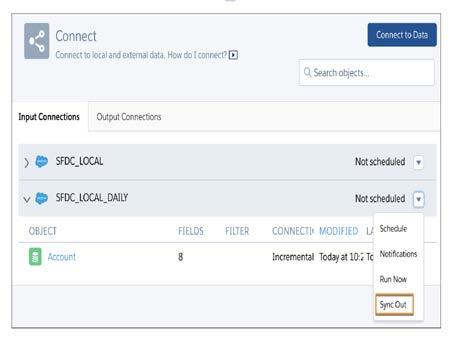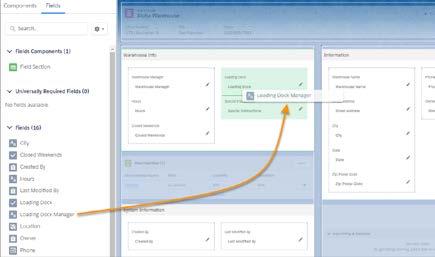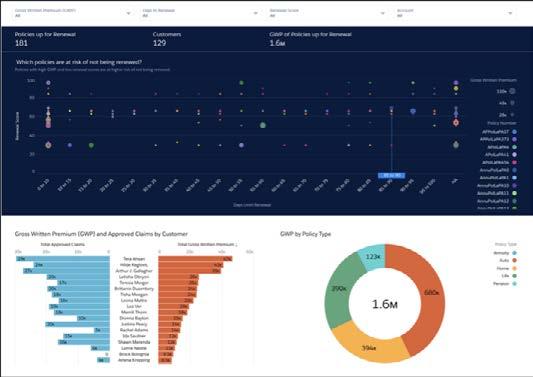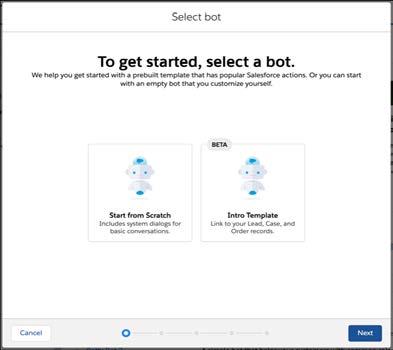
7 minute read
Salesforce Data Hub
Our 5 favorite Tableau CRM trends in Winter ‘21!
We are looking forward to the new Winter 21’ release for Tableau CRM as this update will improve the usability, actionability and customization of Einstein. Salesforce is continuing the strategic trend of moving towards Industry Standards in the Data & Analytics and Business Intelligence space. Next to that, we see Snowflake and Tableau becoming more connected with Salesforce next to a variety of other data sources.
Advertisement
Customizable one-click actions
The time-consuming process of clicking on an account, going to the relevant record and then searching for the new action has been made more efficient by Salesforce. With the new update it has been brought back to a single click directly from the Tableau CRM platform. Actions can be directly employed from the table fields in Lenses and Dashboards. Moreover, the actions that become visible are completely customizable, so you can prioritize the most frequently used actions. This will really speed up working with Tableau CRM.
Tatiana Mashliak, Consultant Data & Analytics
Einstein Discovery is a great tool to upgrade your business intelligence and improve your business’ performance almost effortlessly. Based on statistical modeling and machine learning, Einstein Discovery identifies and visualises insights found in your business data and is able to support CRM end-users with predictions and suggestions. But what about business challenges that require models which aren’t supported yet in Einstein Discovery? Or what about Legacy models or models from other domains that are built and running from other tools?
If your organisation is already working with Data & Analytics for longer, chances are high that developers & data scientists in your organisation already have designed, built and tested statistical modelling in other tools. If your organisation is thinking about getting Tableau CRM & Discovery, there is always this one Data-guy who opposes because the tool doesn’t support his favorite but exotic statistical model (or the very popular TenserFlow). Well, good news!
One of the new Salesforce Winter ’21 Release features (Beta/Pilot available) in Einstein Discovery allows you to implement a certain type of external model into your Salesforce org. In this feature, your team can use their favourite modeling tools to design, build, test and tune TensorFlow models. In this way, your Salesforce team will be able to provide additional and previously unraveled insights. So dust off those use-cases where Einstein didn’t have the right model, and team up with your Analytics partner to innovate! The user-friendly Model Manager wizard guides you through the process. Specify details about the model, variables and outcome your model predicts. Then simply upload the model to your Salesforce org and your users are ready to employ the model’s predictions to achieve superior results! We hope this paves the way for more types of external models & tools in future Releases.
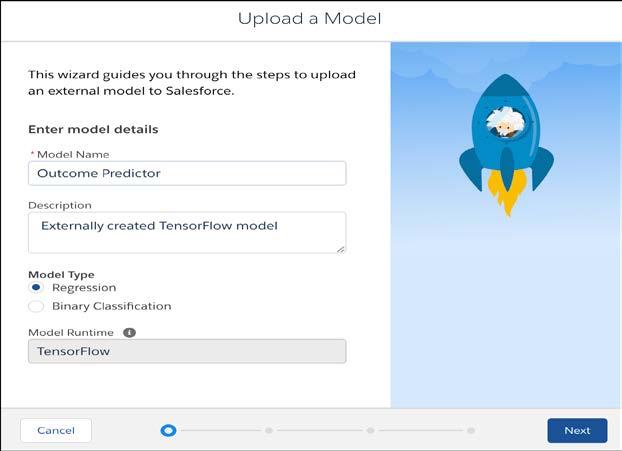
N.b. This feature is currently part of a pilot program in Einstein Analytics and is not yet generally available.
“Many data scientists prefer a specific data modelling tool. Now, they will be able to integrate their own prediction models into Einstein Discovery and compare these with the smart models that are already available in Einstein Discovery. The integration of these tailor-made models into the Salesforce platform will lead to more predictive power and subsequently, superior outcomes!”
Teun Gilissen, Consultant Data & Analytics
Salesforce has made some previously paid features of Einstein available for the whole Salesforce community. Einstein Lead & Opportunity scoring is now available for orgs with and without a Sales Cloud Einstein License. Next to that, they have implemented some minor features to the Einstein Lead and Opportunity Scoring.
Einstein Lead Scoring used to require 1000 new leads and 120 lead conversions to offer lead scoring. Now it uses anonymized aggregated global data to allow orgs without the required data amount to enable Einstein Lead Scoring. When the org has the required data the model will switch from global data to data specific to the org, to allow for more accurate scoring.
In Einstein Opportunity Scoring the scoring model will perform better with accurate data to develop the scoring model. In the new update you can select which opportunities Einstein has to exclude from the data set to increase the accuracy of the scoring model.

Jip Koning - Senior Consultant Data & Analytics
Tableau
Tableau releases four updates per year, we are currently on update 2020.3 so we can expect one more update before the end of the year. These updates are released separately from Salesforce for now but we love seeing that every update Tableau is increasingly becoming more integrated with & in the Salesforce ecosystem.
The huge update on the Tableau relational data model, which we discussed in our previous Release Paper, paved the way for a release with a main theme on the integration of Tableau with Salesforce, but also several cool other external databases and data sources. This is important because Tableau is deployed in a lot of organizations that do not necessarily have Salesforce implemented. Of course Tableau already could integrate with a lot of data, but the integrations are becoming deeper. Notably, and with a hint to our Nextview history in the SAP-space, it is great to see Tableau improved their SAP HANA connector and even offers an official certification for the integration of SAP HANA on Tableau. Changing the Data Model and opening up on integrations also leads to innovations & opportunities of the Tableau “AppExchange” called the “Extension Gallery”. Third parties can now include new connectors in the Extension Gallery to facilitate that data transfer between all kind of different data sources, enabling the strong Tableau community to help improve the product.
The last improvement we want to highlight is on Tableau Data Prep. At the core of getting value out of data, is Data Quality. We all know Garbage in = Garbage out. Tableau Prep Builder is a product designed to make the process of preparing your data for analysis simple and intuitive. Data Prep & Engineering is essential to creating fact-based insights and making the right decision. Tableau Prep uses an intuitive visual experience to simplify the process of publishing a dataflow to a database without the use of code or other tools. With the new update Tableau Prep makes it possible to write data directly to an external database. Users can now make the data preparation process more flexible and more integrated with the existing IT infrastructure. Moreover, Tableau Prep could now be used for use cases outside of Data visualization and Dashboarding. It can be used for Data Science and Data Governance as end users can now edit and publish their data directly to a secure database, making sure that there is full control over this protected data.

“The analytics team at Nextview has a strong history in SAP before focusing on Salesforce, so the SAP HANA integration combines our expertise of SAP and Tableau perfectly. With these new features now implemented in the Tableau Product Suite, it is exciting to see that Tableau is becoming more useful for Enterprise Analytics in big organizations.”
Darren Aletoe, Consultant Data & Analytics
Salesforce bridges the gap between Tableau CRM and Snowflake
Summer 20 release had some new Beta features available between Tableau CRM and Snowflake. These two features, Live Connection and writing from Einstein to Snowflake, are now becoming General Available.
Salesforce & Snowflake are also rolling out new features in beta, our favorite is called “Sync Out”. Without any extra setup you can now sync data directly to Snowflake. As soon as an object sync is completed, and sync out enabled, the object data is synced directly to Snowflake as well. This means you can push the data in the same condition as Analytics received it from Salesforce, with no additional processing time. Applications connected to Snowflake will be using the most recent Salesforce data. This new feature will save users a lot of time in setup or manual syncing data as you can be sure that Snowflake data is always up to date.
